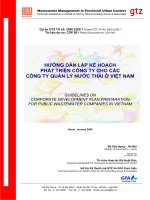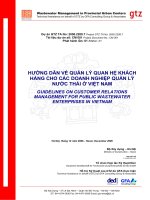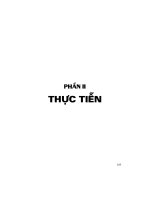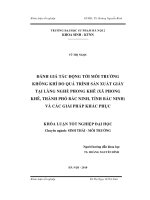QUẢN LÝ NƯỚC THẢI SẢN XUẤT MIẾN TẠI LÀNG NGHỀ ĐÔNG THỌ, THÁI BÌNH, VIỆT NAM
Bạn đang xem bản rút gọn của tài liệu. Xem và tải ngay bản đầy đủ của tài liệu tại đây (221.87 KB, 5 trang )
<span class='text_page_counter'>(1)</span><div class='page_container' data-page=1>
<i>e-ISSN: 2615-9562 </i>
<b>MANAGEMENT OF WASTE WATER TO VERMICELLI PRODUCTION </b>
<b>IN DONG THO VILLAGE, THAI BINH, VIETNAM</b>
<b>Pham Thi To Oanh</b>
<i>Vietnam Cooperative Alliance </i>
ABSTRACT
Dong Tho is a commune of Thai Binh City in Thai Binh province, Vietnam. The major occupation
is the production of vermicelli which is made from edible canna. The pollution characteristic of
Dong Tho commune is the waste water originated from production process. Water pollution is
indicated by the indicators such as TSS, COD, BOD5 are many times higher than the (QCVN 40:
2011/ BTNMT). Specifically, TSS is 5.8 times higher, COD is 1.70 times higher and BOD5 is 3.28
times higher than the permitted standards. Acidic pH in waste water only reached 5.3. Interview
of local people also important base to assess poluttion level. Methods are used such as methods of
collecting and synthesizing data, investigation and fieldwork, analytical methods in the laboratory,
statistical methods, data processing, mapping method. With the current pollution situation in Dong
Tho vermicelli village, the research proposes some management solutions and techniques of
biological waste water treatment. The biological treatment is suitable for local conditions and
feasibility, helps to manage, prevent, and reduce environmental pollution of the waste water
originated from production process, improve the environment of the village.
<i><b>Keywords: pollution; village; discharge; waste water; Thai Binh.</b></i>
<i><b>Ngày nhận bài: 22/02/2020; Ngày hoàn thiện: 29/02/2020; Ngày đăng: 29/02/2020 </b></i>
<b>QUẢN LÝ NƯỚC THẢI SẢN XUẤT MIẾN TẠI LÀNG NGHỀ ĐƠNG THỌ, </b>
<b>THÁI BÌNH, VIỆT NAM </b>
<b>Phạm Thị Tố Oanh </b>
<i>Liên minh Hợp tác xã Việt Nam </i>
TĨM TẮT
Đơng Thọ là một xã thuộc thành phố Thái Bình, tỉnh Thái Bình. Với nghề phụ chủ yếu là sản xuất
miến dong. Đặc trưng ô nhiễm của Đông Thọ là nước thải sản xuất. Các chỉ tiêu ô nhiễm như TSS,
COD, BOD5 đều cao hơn tiêu chuẩn QCVN 40: 2011/ BTNMT. Đặc biệt, TSS cao hơn 5,8 lần,
COD cao hơn 1,7 lần và BOD cao hơn 3,28 lần tiêu chuẩn cho phép. pH chỉ đạt 5,3. Ngoài ra, kết
quả nghiên cứu đánh giá mức độ ô nhiễm dựa trên cả phỏng vấn người dân. Các phương pháp sử
dụng trong nghiên cứu là thu thu thập, tổng hợp số liệu; điều tra, khảo sát thực địa; phân tích trong
phịng thí nghiệm; thống kê, xử lý số liệu; bản đồ.Với thực trạng ô nhiễm hiện nay tại làng nghề
sản xuất miến Đông Thọ, đồng thời nhận thức của người dân địa phương cũng như chính quyền
địa phương, nghiên cứu này nhằm đưa ra một số giải pháp trong quản lý và công nghệ xử lý nước
thải bằng biện pháp sinh học. Xử lý sinh học là biện pháp phù hợp đặc điểm ô nhiễm tại khu vực
nghiên cứu, có tính khả thi cao nhằm hỗ trợ trong quản lý, phòng ngừa và giảm ô nhiễm mơi
trường của nước thải phát sinh trong q trình sản xuất, cải thiện mơi trường làng nghề.
<i><b>Từ khóa: Ô nhiễm; làng mạc; xả thải; nước thải; Thái Bình. </b></i>
<i><b>Received: 22/02/2020; Revised: 29/02/2020; Published: 29/02/2020 </b></i>
<i>Email: </i>
</div>
<span class='text_page_counter'>(2)</span><div class='page_container' data-page=2>
<b>1. Introduction </b>
Water plays a very important role in the
existence and development of humans and all
living things on earth. In the production
process as well as daily life, along with the
increase in the human population, people
have used and discharged a large amount of
waste water into the environment. Waste
water in general has many types depending on
the sources generated, but one type of sewage
which is now seriously polluted and of great
concern is production waste water. The
man-made waste water generated during
production is only partly treated and most of
it has not been treated thoroughly and
discharged directly to the surrounding
environment, causing water pollution [1].
Besides, the community's role in production
waste water management is enormous.
Communities participating in environmental
protection will make all subjects in society
see their role and responsibility in preserving
and protecting the environment. Thereby,
creating habits, building a life in an
environmentally friendly way, contributing to
sustainable social development, is the
concretiation of guidelines, policies and state
laws on the management and treatment of
production waste water into people's lives.
Dong Tho is a commune of Thai Binh city,
Thai Binh province. With the secondary
occupation of vermicelli production, besides
the economic benefits, the expansion of
vermicelli production villages in Dong Tho
commune also increases the amount of waste
generated. Polluted characteristic of Dong
Tho is production waste water. The
communal government has received feedback
and concern from the surrounding communes
and local people were annoyed... Moreover,
Dong Tho commune is on a journey to build a
new countryside, so the issue of green - clean
- beautiful environment, safe production and
business are being paid great attention [2].
It is necessary to have solution to treatment of
waste water in Dong Tho traditional village,
Thai Binh city.
<b>2. Research method </b>
This research collected data on natural and
socio-economic conditions of Dong Tho
commune, available data on water quality of
surrounding areas of Dong Tho commune.
Consulting the authorities and the community
about information on the current state of the
environment, management structure and
environmental management organization in
Dong Tho commune. Moreover, taking water
samples at the study area, preserving samples
as prescribed; analysis of locally collected
wastewater samples. Using complete
documents to map the locations of the study
area to. Using Mapinfo software tools to
<b>assess the environmental status. </b>
<b>3. Results and discussion </b>
Dong Tho is a river suburban commune,
located in the north of Thai Binh city,
formerly the south of Dong Hung district.
Dong Hung district is located in the center of
Thai Binh province. The total natural area of
the district is about 198.4 km2<sub>. </sub>
Dong Tho commune borders Dong Duong
commune - Dong Hung commune in the
north, Dong My commune in the east, Tra Ly
river in the west and Dong Hoa commune in
the south.
Dong Tho commune, Thai Binh city, Thai
Binh province has a vermicelli production
occupation for a long time so it cannot avoid
water pollution. Dong Tho has six production
hamlets such as Doan Ket, Hong Phong,
Thong Nhat, Quang Trung, Tran Phu, Lam
Son. Study areas are shown in Figure 1.
</div>
<span class='text_page_counter'>(3)</span><div class='page_container' data-page=3>
Because in the process of producing
arrowroot vermicelli, the largest amount of
waste water is discharged to the environment
from the starch making stages with very high
organic content, so the problem of water
pollution in vermicelli production villages is
quite serious. In production households, due
to their spontaneous development and limited
investment conditions, it is almost nonexistent
to invest in waste water treatment systems
before being discharged into the environment.
Compact waste water is discharged directly
into the environment, causing heavy organic
pollution in lakes and canals in the production
area. The canals have not been dredged for a
long time, stagnant of pollutants, the
decomposition of organic matters takes place
strongly, causing very uncomfortable smell.
In addition, the amount of daily waste water
is often discharged directly into the sewage
canals, so the pollution is increasing.
Groundwater shows signs of pollution, many
criteria exceed the permissible standards.
Waste water is collected at various locations
(NT). The specific analysis results as follows.
According to the survey data in table 1 and
table 2, on average, each day in the peak
months, each household uses up to 30 m3<sub> of </sub>
water for production, with the amount of
waste water accounting for 70% of the usage.
The indicators such as TSS, COD, BOD5 are
many times higher than the (QCVN 40: 2011/
BTNMT). Specifically, TSS is 5.8 times
higher, COD is 1.70 times higher and BOD5
is 3.28 times higher than the permitted
standards. Acidic pH in waste water only
reached 5.32, proving that the waste water is
sour fermented.
<i><b>Table 1. Analysis results of waste water samples for vermicelli production at producing facilities </b></i>
<b>No. </b> <b>Parameter </b> <b>Unit </b> <b>Results Vietnam standard 40 : 2011/BTNMT </b>
1 pH - 5.32 5.5 - 9
2 COD mgO2/l 255 150
3 BOD5 (20oC) mgO2/l 164 50
4 Amoni (NH4+) (according to nitrogen) mg/l 7.15 10
5 Total nitrogen mg/l 16.7 40
6 Total Phosphorus mg/l 2.45 6
7 Floating solids (TSS) mg/l 580 100
<i>(Source: Center of Science and Environment, VietnamCooperative Alliance, 2018) </i>
<i><b>Table 2. Results of some waste water samples in Dong Tho commune canals </b></i>
<b>No. </b> <b>Criteria </b> <b>Unit </b> <b>NT1 </b> <b>NT2 </b> <b>NT3 </b> <b>NT4 </b> <b>NT5 </b> <b>NT6 </b>
<b>Vietnam standard 40 : </b>
<b>2011/BTNMT </b>
<b>A </b> <b>B </b>
1 Temperature o<sub>C </sub> <sub>25.0 </sub> <sub>25.4 </sub> <sub>25.6 </sub> <sub>24.9 </sub> <sub>24.6 </sub> <sub>25 </sub> <sub>40 </sub> <sub>40 </sub>
2 pH - 6.16 6.71 6.64 6.41 6.29 6.85 6 – 9 5.5 – 9
3 TSS mg/l 320 151 145 205 259 29 50 100
4 COD mgO2/l 318 232 219 272 226 71 75 150
5 BOD5 (20oC) mgO2/l 165 115 145 130 140 40 30 50
6 Clorua (Cl-<sub>) </sub> <sub>mg/l </sub> <sub>145 </sub> <sub>137 </sub> <sub>139 </sub> <sub>141 </sub> <sub>137 </sub> <sub>112 </sub> <sub>500 </sub> <sub>1000 </sub>
7 Amoni (according
to N) mg/l 26.7 18.9 19,2 19.7 16.4 10.8 5 10
8 Total nitrogen mg/l 31.4 27.6 26.1 28.2 24.6 16.1 20 40
9 Total Phosphorus mg/l 4.23 3.59 3.16 3.72 2.97 2.09 4 6
<i>(Source: Center of Science and Environment, VietnamCooperative Alliance, 2018) </i>
</div>
<span class='text_page_counter'>(4)</span><div class='page_container' data-page=4>
decomposes in water causing a sour smell,
reducing the quality of air environment and
causing unsure cleanliness, reducing product
quality. Thong Nhat hamlet has 90
households and Doan Ket hamlet has 81
households producing vermicelli with large
scale. The hamets of Tran Phu, Tan Phong,
Lam Son and Hong Phong have smaller and
medium-scale production with the number of
households from 27-50 households per
hamlet.
<i><b>Figure 2. Current situation of production waste </b></i>
<i>water pollution in Dong Tho commune </i>
NT1: latitude 20o<sub> 29' 23,193", longitude 106</sub>o
20' 4,512"; NM2: latitude 20o<sub> 29' 33,58", </sub>
longitude 106o<sub> 20' 15,88"; NT3: latitude 20</sub>o
29' 28,07", longitude 106o<sub> 20' 16,81", NT4: </sub>
latitude 20o<sub> 29' 29,729", longitude 106</sub>o<sub> 20' </sub>
35,233", NT5: latitude 20o<sub> 29' 34,661", </sub>
longitude 106o<sub> 20' 25,737", NT6: latitude 20</sub>o
29' 48,828", longitude 106o<sub> 20' 30,736". </sub>
Six represenrative sites were select to assess
the quality of waste water origined from
production, belong to six hamlets of Dong
Tho. Current situation of production waste
water pollution in six represenrative sites
Dong Tho commune are shown in Figure 2.
Six represenrative sites were select to assess
the quality of waste water origined from
production.
There are 321 households producing in the
commune, so the amount of waste water
discharged in the whole production area can
be calculated as follows:
321 30 70
741
=
%
6
<i>sx</i>
<i>W</i>
=
(m3<sub>/day). The </sub>interview results of some officials in Dong
Tho trade village are as follows:
Communities are fully aware of the current
pollution problem of the trade village mainly
due to the waste water from vermicelli
production. All 6 villages have high
percentage (%) of agreement that the cause of
water pollution is mainly due to the
production of vermicelli (Thong Nhat hamlet:
70%, Doan Ket hamlet: 74%, Tran Phu
hamlet: 44%, Quang Trung hamlet: 50%,
Lam Son hamlet: 58%). Regarding the
harmful effects of pollution, most people
realize that the environment is polluted, but
about its harm, it seems that the community
do not consider it very dangerous, so they
have a thought of accepting the fact that
“producing and living together with
pollution”.
On the non-production households, there are
two opinions: some are pressing on the
discharging issue and some are sympathizing
with the producers.
On the part of the producers, they do not want
to talk about the pollution aspect or think that
it is the general situation of the whole village,
there is no other way. They think it is
sufficient for households to have their own
waste water treatment system (in fact,
sedimentation tanks) as the instructions from
commune for years.
</div>
<span class='text_page_counter'>(5)</span><div class='page_container' data-page=5>
Local authorities are often asked to stop
production by neighboring villages and
communes.
The proposed solution of the study of Dong
Tho trade village waste water characteristics
is the treatment technology with biological
measure. The first advantage of the solution is
that the initial investment cost for the system
is not too large, consistent with economic
conditions of the production households in
Dong Tho commune, which can be developed
and replicated in accordance with reality.The
treatment system does not require large space
to operate because the sedimentation tank,
limestone neutral tank, anaerobic treatment
tank are built underground; the operation of
the system is simple with the common
material source. The technical requirements to
operate the system are not high, easy for
people to apply and it can run in automatic
mode [3-5]. System of vermicelli waste water
treatment by biotechnology consist of filter
tank 1, filter tank 2, sedimentation tank,
limstone,air blower, anaerobic tanks,
pumping chamber,.. It is shown in Figure 3.
<i><b>Figure 3. Biotechnology diagram of vermicelli </b></i>
<i>waste water treatment</i>
<b>4. Conclusions </b>
Current situation of pollution of production
waste water in Dong Tho commune may vary
at each village and at different time but the
most polluted time is in August and near the
Tet holiday because this period are peak
production time to serve the needs from the
market. The pollution of water environment is
expressed through the criteria of BOD, COD,
TSS, Total N, Total P, pH ... In the analyzed
water samples, the content of TSS, COD and
BOD is many times higher than the permitted
norms. The air and groundwater in the
commune also show signs of spreading
pollution due to the spread of impurities from
the waste water and surface water. In the face
of the ongoing pollution situation in the
vermicelli village of Dong Tho commune and
the awareness of the people and local
authorities, the study proposes a number of
management solutions as well as waste water
treatment techniques to manage, prevent and
minimize pollution of production waste water
in Dong Tho commune in order to protect and
improve the trade village environment:
management solutions, technical solutions,
and solutions to promote the role of
community in management of production
waste water. Especially, community-based
management solutions, promoting the role of
community and biological measures in waste
water treatment are essential.
REFERENCES
<i>[1]. T. T. O. Pham, Community-based trade </i>
<i>village environment management, 3-year </i>
<i>project 2014 - 2016, Vietnam Cooperative </i>
Union, 2016.
[2]. People’s Committee of Dong Tho commune,
<i>Summary reports on new rural construction in </i>
<i>Dong Tho commune in the period of 2011 - </i>
<i>2014, 2015, 2016, 2017, Vietnam. </i>
<i>[3]. V. C. Le, Adsorption and ion exchange in </i>
<i>water and waste water treatment techniques. </i>
Statistical Publishing House, Vietnam, 2002.
<i>[4]. V. C. Le, Integration system in waste water </i>
<i>treatment technology - vol.1. Statistical </i>
Publishing House, Vietnam, 2014.
</div>
<!--links-->









